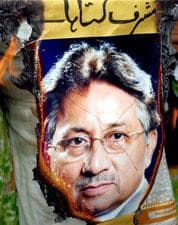Advertisement
After Musharraf
Resume
He was a general who took power in a bloodless coup. He was disdainful of the workings of democracy. He was America’s man, formally, in the war on terror.
And today he’s headed out — resigning in a hail of criticism from Pakistanis fed up with the Musharraf era. And the Taliban is on the rise.
This hour, On Point: Musharraf goes, and Pakistan and the U.S. ask, what next in the world’s most dangerous neighborhood?
You can join the conversation. Is this a crisis? A triumph for democracy? A turn toward hope? Or chaos? Tell us what you think.
* * *
Guests:
joining us from Islamabad, Pakistan, is Candace Rondeaux, foreign correspondent for The Washington Post. She reports here on Musharraf's resignation.
Joining us in our studio is Adil Najam, professor of international relations and director of the Pardee Center at Boston University.
From East Hanover, New Jersey, we're joined by Azmat Hassan, former Pakistani ambassador to Morocco, Syria, Lebanon and Malaysia, and former adviser to Benazir Bhutto and Nawaz Sharif. He is now a professor at the Whitehead School of Diplomacy at Seton Hall University.
And joining us from Washington is Daniel Markey, senior fellow for India, Pakistan, and South Asia at the Council on Foreign Relations and a former member of the State Department's Policy Planning Staff for South and Central Asia.Multimedia:
The AP offers this video report on Pervez Musharraf's resignation earlier today:
This program aired on August 18, 2008.